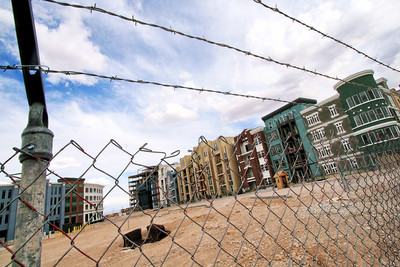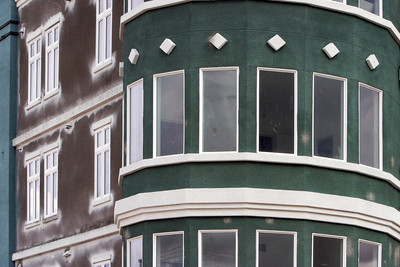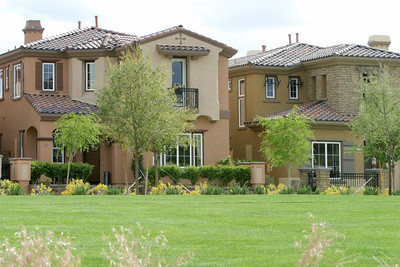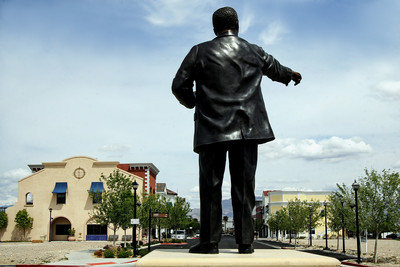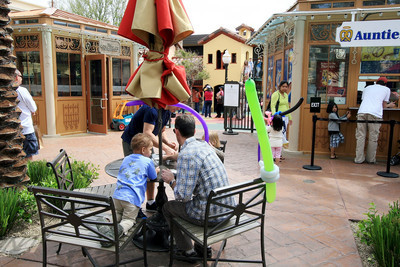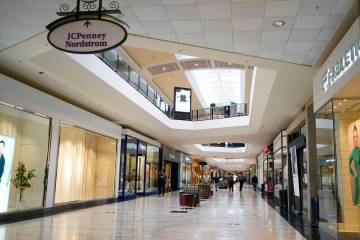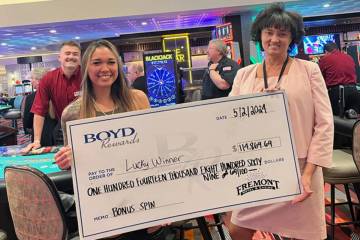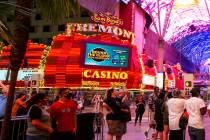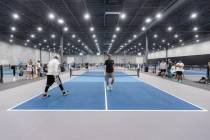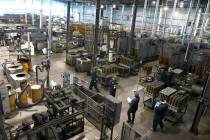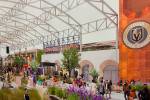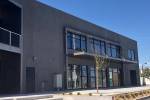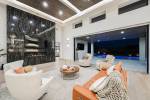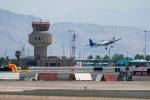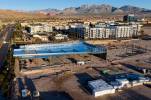Recession means dream developments in Las Vegas Valley will have to wait
With vacant lots equaling the number of completed buildings and "for rent" signs taped inside many of the windows, the Village of Centennial Springs looks much like commercial real estate projects all over the valley.
But what sets it apart from hundreds of strip malls and office parks, and easily visible from U.S. Highway 95, is the design based on a set of standards known as new urbanism. With traditional-looking streetscapes reminiscent of Andy Griffith's idyllic Mayberry and a seamless mix of stores, offices and different types of housing, new urbanism was supposed to start steering Las Vegas away from car-centric, suburban "blah" and toward pedestrian-friendly, sociable neighborhoods.
The Village of Centennial Springs was just one of several new urbanism projects either planned or partially built.
"Inspirada brings to the valley ... a community unlike any other in Las Vegas," Focus Property Group Chairman John Ritter said two years ago, in describing the 1,950-acre Henderson subdivision then touted as the largest new urbanist project in the country. "The lifestyle we are promoting will reinstate the sense of community. Residents will be encouraged to know who their neighbors are and to interact with one another."
Market reality, however, has interrupted much of that new urbanist dream. Some projects, such as Inspirada and the Village, exist only as fragments of their master plans with no completion dates in sight. Several others either slowed the pace of construction dramatically, ran out of money before completion or never moved past the rendering stage.
Although real-estate observers expect new construction to rebound someday, as the huge surpluses in both residential and commercial property are whittled down, large questions loom about new urbanism's viability. Now, however, the recession makes it difficult to separate any new urbanism shortcomings from the recession.
"I don't care if it's new urbanism or old urbanism, nothing is working right now," Home Builders Research President Dennis Smith said. "It's too early to tell what will happen with new urbanism."
Still, real estate executives have taken up sides. Some contend that Las Vegas' limitations, including a shrinking supply of open land, traffic woes and infrastructure costs, will eventually force the higher densities that come with new urbanism.
"There's no question that new urbanism is in the future of Las Vegas," said Steve Bottfeld, principal of the research firm Marketing Solutions. "It's not a future, it's the future. But it isn't going to be tomorrow. It's going to take anywhere from a decade to a quarter century."
But skeptics foresee an adoption process that will run well behind the pace in other cities or may have to change substantially to take root in a city that never had original urbanism.
Astoria Homes President Tom McCormick, while liking new urbanism and having borrowed some elements for his projects, believes it appeals to a "very targeted market, not the mass market" in part because of the cost.
"If I could do new urbanism less expensively than tried-and-true, then it would probably work," he said. "But typically, it costs more."
Moreover, he said, the layout of Las Vegas does not lend itself to walking to stores or restaurants, so commercial or public amenities of a new urbanism project must be constructed first to create pedestrian destinations.
Pulte Homes and subsidiary Del Webb, which led the market with 806 new-home closings last year, have built several new urbanism projects in California but stuck to conventional single-family tracts in Las Vegas.
"We do a lot of survey among our customers to determine what we build," spokeswoman Courtney Rice said. "We just have not seen the demand (for new urbanism) among our customers. Northern and Southern California are dramatically different than Las Vegas."
Partner Rick McCarty at Rhapsody Partners, the developer of the Village, has remained a new urbanism booster but added that his move to Seattle three years ago after a quarter century in Las Vegas has given him a whole different perspective.
"This is a much more mature community that has really embraced mass transit and higher density," he said, noting that Seattle's zoning laws, which steer development within certain boundaries, helped the trend. "Do I think it will happen in Las Vegas? I do. But I don't know when, except that it will be more of an evolutionary process than a revolutionary process."
First, he said, the Las Vegas Valley will have to eat through the excess of houses, offices and shops produced during the bubble earlier in the decade, then the raw land purchased in expectation of a boom that would never end. After that, he expects new urbanism to reverse itself, with projects appearing in the core of the city -- he views the intersection of Charleston Boulevard and Eastern Avenue as a promising area -- instead of on the periphery where the recent crop of projects was planned or built except for downtown's Union Park.
The exceptions to the pattern were the downtown condominium towers that sprouted in the past few years. Although not new urbanist by themselves, they were touted as key components in Mayor Oscar Goodman's new urbanist vision of a city center where people lived, worked, shopped and sought entertainment all within walking distance.
However, many of the units either did not sell or were snapped up by speculators, who did not close deals when housing values started to plummet.
McCarty believes that what will eventually work is rental housing aimed at people who work on the Strip, and not condominiums with prices that started around $400,000 and soared past $1 million.
To a degree, the local outlook for new urbanism reflects national concerns. Robert Steuteville, publisher of the New Urban News in Ithaca, N.Y., recently raised the issue of whether new urbanism would be buried by the real estate implosion much as early 20th century urban planners saw their ideas crushed by the Depression. He concluded that larger forces, such as energy costs and pollution, would sustain new urbanism through lean times.
The track record for what has been built in Las Vegas is mixed, partly because the projects embody only some of the 13 principles that define new urbanism. At the Village, which played enough on nostalgia to name its entry street Norman Rockwell Lane, several merchants remain upbeat about the design.
"It does work. It will work. I just can't tell how well due to the economy," said Rebecca Eli, who owns the candy shop Rainbow Sweets. "The response from the customers has been phenomenal to the trees along the street, the park and just being able to walk around."
Landscaped and relatively narrow streets are designed to lure people from their cars and get them on foot.
"We get people who walk up and down the street and seem to enjoy it," said Kathi Enns, who is helping her daughter and son-in-law run Amanda LaVoy's Flower Boutique. "Even in hard times, we're still optimistic that things will turn around. We love the feel here."
Enns, who previously owned her own shops, noted that strip malls are designed to move people in and out as quickly as possible.
To try to attract more shoppers, shop owner Jason Cheek is organizing a weekend farmers market for the small park at the end of the street, with its traditional-looking gazebo and a bronze statue of Las Vegas business pioneer C.P. "Pop" Squires. Rhapsody will also restart the free outdoor summer movies in the park, a staple at both the Town Square center south of Mandalay Bay and the District at Green Valley Ranch Resort.
However, a couple of the businesses that opened just last year at the Village have already closed, partly because only a handful of the planned surrounding homes have been built. Only one of the second floor offices has been leased.
The 1.6-million-square-foot Town Square has filled much of its retail space and attracted thousands of shoppers with its retro architecture, slow interior streets and green center. But two years after opening, the 355,000 square feet of upstairs office space remains 77 percent vacant even after some recent leases. The Las Vegas Chamber of Commerce is the only large tenant.
Owner Turnberry Associates said discussions are under way with tenants interested in another 120,000 square feet, but nothing has been signed.
Brad Peterson, a senior vice president at commercial brokerage CB Richard Ellis, said many office tenants have long wanted locations within walking distance of amenities such as restaurants. The interest by companies in the Tivoli Village at Queensridge for 200,000 square feet of offices and more than 500,000 square feet of retail in a European setting, and that the 77,000 square feet of offices over the stores at the District at Green Valley Ranch Resort initially leased faster than an adjacent free-standing office building shows the concept's strength, he said.
However, he added that new urbanist offices often charge higher rents than conventional offices, making them a tough sell in the current economy.
But Turnberry said its design and low common-area charges bring down the total rent.
Spokesman Rob Benson said District developer American Nevada Co. considers the project and new urbanism a success. But he could not explain why the second retail phase, which opened in May 2006, reverted to a traditional mall design and did not follow the Main Street-style, pedestrian-only zone used two years earlier in the first part.
Because of its start several years ago, the District did sell the 88 condos over the stores in the first phase. But Robin Civish, a senior commercial adviser at Prudential CRES/IPG who is handling the Village, said over-the-shop housing has become a difficult sell "because there are so many other options out there."
Contact reporter Tim O'Reiley at toreiley@lvbusinesspress.com or 702-387-5290.



